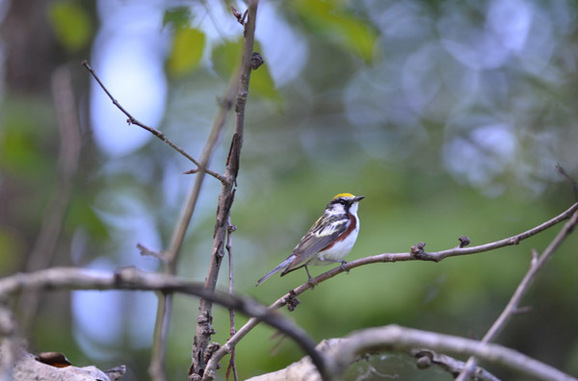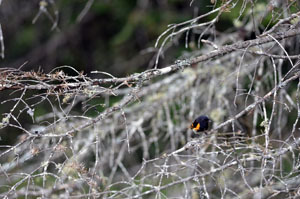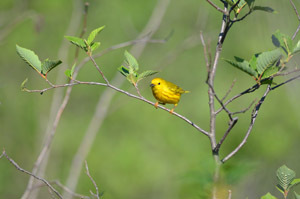 May 7, 2018
Contact: John Pepin, 906-226-1352
DNR offers ‘Wildlife Through Forestry’ songbird
forum in Marquette
From work to recover threatened and endangered species, including piping plovers and Kirtland’s warblers, to studying edge effects on songbirds in northern Wisconsin, three biologists assembled to speak at a forum in Marquette this month are highly-skilled in their professions.
Their previous working locations range from the Midwest to Texas and Oklahoma to Latin America and Hawaii.
 “May is a
prime time to talk about songbirds, especially with the spectacular spring bird
migration under way here in Michigan,” said Gary Willis, a Michigan Department
of Natural Resources service forester from the Baraga office. “This is the time
of year birdwatchers are focused on a vast variety of returning songbirds.”
The event,
which features Katie Koch and Vince Cavalieri of the U.S. Fish & Wildlife
Service and David Flaspohler from the School of Forest Resources and
Environmental Science at Michigan Tech, will be from 6 to 9 p.m., Thursday, May
17 in the Michigan Room at the University Center on the campus of Northern
Michigan University in Marquette.
|
Koch is a
U.S. Fish and Wildlife Service biologist who founded the Midwest Coordinated
Bird Monitoring Partnership and Midwest Avian Data Center. She has served on
more than two dozen regional and national teams. Koch is focused on
conservation of birds in northern forest landscapes, launching the Midwest
Migration Network, sustain Kirtland’s warbler throughout their annual cycle,
and growing the Midwest Avian Data Center to be the 1-stop shop for bird
information throughout the Midwest region.
Cavalieri
is also a wildlife biologist with the Fish and Wildlife Service. There, he has
been the Great Lakes Piping Plover Recovery coordinator for five years. His
primary interest is in ecology and conservation of birds, including cerulean
warblers, mountain plovers, Kirtland’s warblers and trumpeter swans. Cavalieri
worked previously for the Oklahoma Cooperative Fish and Wildlife Research Unit
in the Lower Rio Grande Valley of Texas.
Flaspohler
has been an avian conservation biologist in the School of Forest Resources and
Environmental Science for two decades. He received his master’s degree and
doctorate from the University of Wisconsin, where he studied edge effects on
songbirds in northern Wisconsin. Since then, he has conducted research in other
parts of the Great Lakes region, Hawaii and several countries in Latin America.
 “This event,
the latest in a fascinating series of ‘Wildlife Through Forestry’ forums held
in the western Upper Peninsula over the past several months, comes on the heels
of a raptor forum held at NMU last month,” said John Pepin, DNR deputy public
information officer. “These sessions link wildlife topics to the numerous ways
habitat for birds and animals may be developed and enhanced for a range of
species on private lands.”
The
forums have been presented by the DNR with funding from a Natural Resources
Conservation Service grant.
|
Each of these sessions has included a presentation on an interesting and important wildlife-related topic, with additional information provided to private landowners on the value of a Forest Stewardship Plan.
“We’ve had a great time at these sessions and we anticipate the songbird forum to be no exception,” Willis said.
 A panel of resource professionals will be on
hand to discuss the development, preparation and implementation of Forest
Stewardship Plans.
More than 150 professional foresters and 20
wildlife biologists develop Forest Stewardship Plans for forest landowners
in Michigan. For information about these plans or the Commercial Forest Program, contact Gary Willis,
DNR Service Forester, 427 U.S. 41 North, Baraga, Michigan, 49908; 906-353-6651,
ext. 122 or willisg2@michigan.gov.
Many county conservation districts in Michigan
have foresters on staff available for a free site visit to private landowner
properties. They can discuss landowner wildlife habitat and forestry goals and
help decide if there are financial assistance programs that can provide cost sharing
for resource management plan preparation and implementation.
For Marquette County, contact Matt Watkeys, forester,
at matt.watkeys@mi.nacdnet.net or call the Marquette
County Conservation District office at 906-226-8871, ext. 128.
|
Note to editors: Accompanying photos
are available below for download. Suggested captions follow. Credit: Michigan
Department of Natural Resources, unless otherwise noted.
Chestnut:
A male chestnut-sided warbler sports his spring colors in Marquette County.
Myrtle: A
male yellow-rumped warbler (myrtle race) is perched on a limb as spring emerges
from a long winter.
Redstart:
An American redstart sits on a branch over the Peshekee River in Marquette
County.
Yellow: A
male yellow warbler sits over a wetland area, decked out in spring plumage./
|